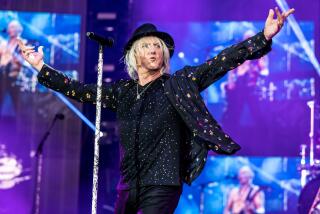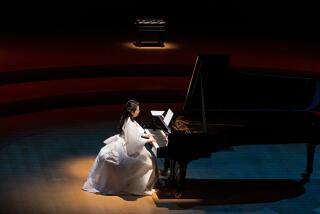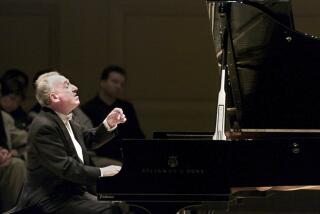BOW TIES : At 84, Stephane Grappelli Is Still Pretty Attached to His Jazz Violin
Even as he approaches his 85th birthday, Stephane Grappelli continues to be much like his music: always on the move and full of turns and changes.
“My nature is like a gypsy,” the violinist said last week by phone from Ft. Worth, Tex., where he appeared at the city’s Caravan of Dreams performance space. “I like to travel, you know, maybe not as much as I used to, but I still like to keep moving and like to change. After three days anywhere, I’m ready to go somewhere else.”
Grappelli, who’s in the middle of a 2 1/2-week U.S. tour that includes stops at the Strand in Redondo Beach Friday, the Coach House in San Juan Capistrano Sunday and Pasadena’s Ambassador Auditorium May 6, first came to the jazz world’s attention back in the 1930s when he teamed with legendary Gypsy guitarist Django Reinhardt.
It was 1934 when the two formed the Quintette du Hot Club de France, named for the Paris club where they performed for five years. Maybe some of his onetime partner’s ancestry rubbed off on him during their long association, a relationship that continued on and off until the guitarist died in 1953.
“You know, I think I was more of a Gypsy than he was,” Grappelli said in a melodious French accent. “He was a sit-down. He didn’t like to move, which is very rare for his people. But me, I live to move.”
Grappelli continues to play some of the music he wrote with Reinhardt more than 50 years ago, particularly the well-known “Nuage.”
“I do that because of the good memories I had with him,” Grappelli said. “And I must play ‘Nuage’ because the people who come to see me want to hear it.”
But for the most part, his concerts concentrate on great American composers--Jerome Kern, George Gershwin, Cole Porter, Duke Ellington--and such American songs as “Honeysuckle Rose,” “Blue Moon” and “Makin’ Whoopee.”
“I have a very big range of compositions,” he said. Kern, Gershwin, Porter and Ellington are the “greatest composers of American jazz, I think. It’s the best music you can play.”
Though his playing remains as sweet and smart as ever, and his sense of swing is undiminished, Grappelli is sometimes criticized for continuing to present the same songs.
“We don’t always play the same tunes,” he said. “Every few months we decide to do something new. For instance, we did that at our last show, (played) Cole Porter’s ‘Love for Sale.’ And we’re improvising all the time with our music. So, of course, if you improvise, you never do the same thing.”
And indeed, a tune like “Honeysuckle Rose” may go through a number of rhythmic and improvisational alterations under Grappelli’s bow.
After a considered introduction that seems to be built on an almost classical figure, the violinist will swing into the theme. His improvisation may climb through various key changes, the rhythms suddenly shifting into double time, and he might exchange heated choruses with the guitarist in his trio (currently Bucky Pizzarelli).
“Honeysuckle Rose” was “one of the first tunes I ever played in my life,” said the 66-year-old Pizzarelli, who is best known for a long tenure with Benny Goodman as well as stints with everyone from Vaughn Monroe to Zoot Sims.
“I learned it by ear, playing with my uncles. Over the years, I’ve played it with quite a few different people, and you do it the way they want you to do it. But (Grappelli) does it a certain, very exciting way. He’s the master of the cadenced ending--you don’t just fall off a cliff when you come to the end of a song. You have to make it end right, as if you’re playing for dancing. And he’s got a knack for that.”
But why, with his affinity for change, doesn’t Grappelli expand his repertoire with something from, say Dizzy Gillespie, Thelonious Monk or Miles Davis?
“I like all those people and knew them--I know Dizzy Gillespie very well. They all play very good jazz. But, no, no, I’m not a be-bopper. I don’t know if what I’m doing is right or not, and I don’t like to critique anyone else. I just prefer my own cooking, my own cuisine.”
Grappelli began his professional career while still a teen-ager in Paris, playing in theater orchestras, in restaurant dance bands and even on the streets. He first heard American jazz in a local record shop and left the violin behind to play jazz on the piano until a friend persuaded him to return to the stringed instrument, though the piano remains another passion for him.
It was his relationship with Reinhardt that brought him to the world’s attention. In addition to Grappelli and the guitarist, the all-string ensemble included two rhythm guitarists and a bassist, creating a warm, percussionless blend that has become identified as uniquely European.
Though the inspiration for this sound has often been credited to the duo of Joe Venuti and guitarist Eddie Lang, who began playing together in the 1920s, or the influence of Missouri-born violinist Eddie South, who toured Europe in the late ‘20s and again in the ‘30s, Grappelli, in an interview with The Times last year, said there was little connection:
“No, I never copied anybody. I played with South in 1937, but I didn’t know him before. When I heard him, I realized what a great artist he was, what an improviser. And Joe Venuti. Those were the only violinists I knew well before” World War II.”
The reason behind the all-string instrumentation was a matter of preference--and a need to be heard.
“I wanted all string instruments to play jazz without a microphone, not like today. There was no electric (amplification) in back of us, and the violin would not be heard very well (in a group with horns and drums). It was a different picnic then for the violin.
“But now everybody, even Joe Venuti, my dear friend--I saw him in Chicago when he was still alive--he played electric violin. And that from a man who had such a lovely tone. I regret that he did that.
“But I don’t want to play electric violin, not any day, not in any case. I keep playing acoustic violin and, of course, for the people to listen to me, I need to have a microphone in front of me. It is very easy to sound good with an electric violin, but I will not do it.”
Grappelli spent World War II in London, where he often played with pianist George Shearing, sometimes under difficult circumstances.
“We were playing a theater once and Beryl Davis, the singer, was with us. In England at that time there were musicians everywhere. Sometime in the middle (of the performance), a bomb dropped. Beryl was singing ‘As Time Goes By’ and the bomb dropped. We managed to get out of that. We were lucky.”
Since the war, Grappelli has worked with everyone from guitarist Joe Pass, saxophonist Phil Woods and accordionist Marcel Azzola to such greats of the classical realm as Yehudi Menuhin and Yo-Yo Ma.
Throughout his career he has sought out other violinists with whom to blend his sound, a group that includes Venuti, South, Claude Williams, Stuff Smith and Ray Nance. He’s shown a special interest in younger violinists, encouraging the careers of such artists as L. Subramaniam and fellow Frenchmen Didier Lockwood and Jean-Luc Ponty.
In 1981 and ‘82, he toured with mandolinist David Grisman, whose jazz-meets-bluegrass band included young violinist Darol Anger, now a member of the Turtle Island String Quartet.
“Stephane was one of my first inspirations to play jazz violin,” Anger said, “and I was just in awe when I was on stage with him, trying to soak up everything I could. He’s not the kind of person who would sit you down and formally show you what to do. Instead, while we were on stage, he would walk over to me and look me right in the eyes while he continued to play.
“When you hear him, he sounds like a very light player, applying such little pressure, just floating over the notes. But being right next to him, I realized what force and strength he has.
“But it was his attitude I learned from most; that music comes from some deep and emotional place. Just by example, he was a great inspiration to my playing.”
“He’s also a fantastic piano player in that Fats Waller, Art Tatum style,” Anger added. “He would be well known as a pianist if he were not such an amazing violinist.”
Grappelli, who released an album of piano music in 1990 titled “My Other Love” and who takes a brief turn at the keyboard during most of his performances, speaks in modest terms about his abilities on the instrument.
“I don’t have much technique,” he said, “because I taught myself. Art Tatum is my hero. In general, I think he’s the greatest musician of all time.
“The piano can do everything--the melody, the accompaniment--everything. . . . I love to do a song or two. It gives the other musicians a little rest and puts something different on the stage.”
When in France, Grappelli splits his time between Paris (“my business home, because everything happens there”) and Cannes, where he has family.
“I go there for pleasure,” he said. “There are many (music) festivals there, and the American movie stars all go there once a year. And there are, uh, I don’t know how to say it in English, many interesting rendezvous places there. That is what my life is like. It is quite well occupied. And I will keep playing till the end.”
Who: Stephane Grappelli.
When: Sunday, May 3, at 8 p.m. With guitarist Bucky Pizzarelli and bassist John Burr.
Where: The Coach House, 33157 Camino Capistrano, San Juan Capistrano.
Whereabouts: San Diego Freeway to the San Juan Creek Road exit. Left onto Camino Capistrano. The Coach House is in the Esplanade Plaza.
Wherewithal: Tickets: $26.50.
Where to call: (714) 496-8930.
More to Read
The biggest entertainment stories
Get our big stories about Hollywood, film, television, music, arts, culture and more right in your inbox as soon as they publish.
You may occasionally receive promotional content from the Los Angeles Times.










